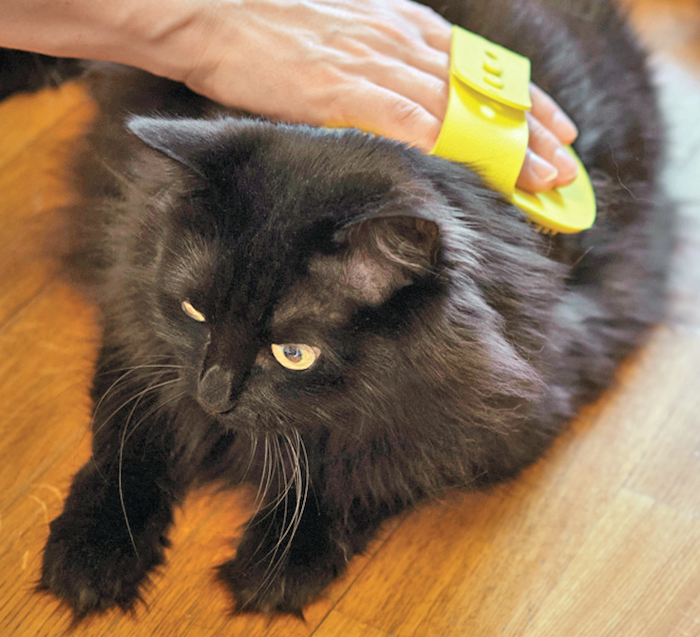You’ve probably seen the slogan “Cat hair, don’t care!” on t-shirts and coffee mugs. And while it sounds cute, sometimes cat hair is, well, everywhere.
The presence of dandruff or abnormal shedding patterns is a signal that something isn’t quite right with your cat’s skin and coat. Causes range from simple and easy to fix, to more severe illnesses and conditions.
The good news is that one of the primary ways to support the health of your cat’s skin and coat is through her food. “In my opinion, a healthy cat eating a good quality food needs no supplements because the food has all the ingredients in the correct proportions,” says William Miller, VMD, DACVD, Professor Emeritus of Medicine, section of dermatology at the Cornell University College of Veterinary Medicine.
Normal Shedding
“Normal shedding is a whole-body event not restricted to one small area or a region of the body,” says Dr. Miller. “Animals shed year-round with typically two heavy periods in spring and fall.”
When your cat sheds, old hairs are falling out to be replaced by new ones. This is a constant process, which is why you will usually get some hairs whenever you pet your cat. As the seasons change, the shedding cycle can accelerate to accommodate building up a thick winter coat or thinning the coat down for summer. These heavy shedding periods typically last a couple weeks, and then your cat’s shedding will slow down again.
For normal shedding, your cat’s coat will still appear shiny and full. There should not be bald or thin patches.
Sometimes during a heavy shedding period, your cat may have tufts of loose undercoat that can be easily plucked. “Pluckables” are not a concern unless plucking leaves a bald spot or they become an issue that doesn’t go away.
In longhaired cats, mats and tangles may prevent dead hair from falling out normally. Grooming with a brush or comb can help to catch any knots early and keep your cat looking her best.
Stress and Shedding
A cat who is stressed or afraid will often shed more heavily. While the shedding may seem excessive, it is a normal expression of stress and will usually resolve once your cat is back home and relaxed. This heavy shedding can be accompanied by mild dandruff that will also resolve once your cat is comfortable again.
Normal Skin Cycle
As well as shedding hair, your cat also sheds skin cells every day. As new skin cells are produced, old dead ones fall off. “This shedding usually is invisible because the sloughed cells are so small,” says Dr. Miller. This normal skin shedding is also referred to as dander.
Dandruff, on the other hand, is when an abnormality in the skin causes cells to flake off in sheets that are visible to the naked eye. It is typically light in color and might look like snowflakes. “If the skin is diseased, it can produce more cells than normal and those aren’t shed normally, hence dandruff,” says Dr. Miller.
Low humidity can cause dandruff as well. If your home is very dry and your cat’s skin otherwise appears healthy, it is not a cause for concern.
When to Seek Help
Dr. Miller advises scheduling an appointment with your cat’s veterinarian if her shedding is “excessive, prolonged, or unusual for the cat.” Two indications that shedding is not normal are the presence of bald patches and/or dandruff.
Hair that is coming off in clumps that leave bald or visibly thin areas in the coat is not normal. This can be caused by parasites, such as fleas or ringworm, or other skin disorders.
An unkempt coat is also a sign that something isn’t quite right. “If the apparent normal shedding leaves the cat with a horrible coat, then it’s not normal shedding but an indication of internal or external disease,” says Dr. Miller.
An abnormal coat might appear greasy or dull, or sport flakes of dandruff. Dandruff can sometimes occur along with a seasonal shed, but if it persists, something is up.
Skin that is red, itchy, or covered in sores is a problem, but even bald patches that reveal normal-looking skin should be checked out.
Causes of Dandruff and Hair Loss
Causes of dandruff and abnormal hair loss include:
- Allergies
- Cutaneous (on the skin) lymphoma
- Excessive grooming
- Fleas
- Low humidity
- Mange
- Nutrient imbalances
- Obesity (prevents normal grooming)
- Ringworm
What You Can Do
Make sure your cat is eating a complete and balanced diet. As Dr. Miller stated, a good cat food contains all the nutrients that a healthy cat needs. If your cat is eating a low-fat diet, a fatty acid supplement may help to boost coat and skin health if the coat seems a bit drab. Cats with skin or immune system disorders may also benefit from supplements.
Brush or comb her hair, especially during heavy shedding cycles. Some light grooming with a brush or comb can help remove dead hair so that it doesn’t all end up on your clothes, furniture, or in a hairball. Brushing will also help to encourage normal skin cell shedding and prevent or limit dandruff.
Use a humidifier during the winter to help prevent the air from getting too dry and drying out your cat’s skin.
If you need to bathe your cat, always choose a shampoo formulated for cats for both safety and proper pH for feline skin.
Consult with your veterinarian. If something doesn’t feel right, consult with your veterinarian to make sure that your cat’s skin and coat are healthy.




